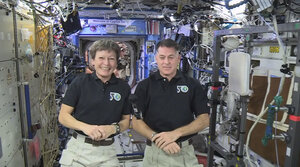ISS rehab: How do you change a lithium-ion battery in space?
Two astronauts took a risky spacewalk Friday as the part of a long-term effort to upgrade the batteries on the International Space Station's power grid.

In this image made from video provided by NASA, US astronauts Peggy Whitson (l.) and Shane Kimbrough speak from the International Space Station during an interview on Tuesday, Jan. 3, 2017. The two performed spacewalks to replace batteries for the station on Friday.
NASA/AP
Two astronauts went spacewalking on Friday as they began the two- to three-year task of replacing all the batteries for the International Space Station’s power grid.
NASA astronauts Shane Kimbrough and Peggy Whitson, the world’s oldest most experienced spacewoman, undertook a risky 6.5-hour spacewalk outside the 250-mile-high station.
Their mission was to wire up three new lithium-ion batteries, each about the size of half of a refrigerator that Houston controllers had already replaced remotely, via the station’s onboard, 11-foot-long-armed robot Dextre.
The project to swap out the station’s decade-old nickel-hydrogen batteries began on New Year’s Eve, 2016. The lithium-ion replacements are much more efficient, meaning only 24 will be required to replace the 48 old ones.
"The batteries that are out there now have been up here for the duration of the space station, some over a decade and the others even more, so it's just time to change them out," EVA flight director Jud Frieling said in a NASA TV briefing.
Prior to the spacewalk, Dextre, short for the Dextrous Manipulator, removed the new batteries and adapters from the Japanese HTV-6 cargo spacecraft that delivered the equipment along with other supplies to the ISS earlier in December.
Dextre was charged with removing the old batteries and replacing them, but also loosened bolts, which held down metal plates that came with the new batteries and often prove difficult for astronauts, according to NASA's chief astronaut, Christopher Cassidy, said from Mission Control. Mr. Kimbrough and Ms. Whitson were charged with installing those plates along with power and data cables.
"If we didn't have the robotics helping us out, it would be six spacewalks" instead of two, Ms. Whitson said, according to Space.com.
ISS astronauts try to minimize the amount of time they spend outside the station, because spacewalks carry significant risks – a fact clearly underscored by the presence of Italian astronaut Luca Parmitano at Mission Control. Mr. Parmitano nearly drowned during a 2013 spacewalk after his helmet flooded with water from his space suit’s cooling system.
Friday’s spacewalk was the first of two that ISS astronauts will make as part of the station’s power grid upgrade this month. On Friday, Jan. 13, Mr. Kimbrough will head out again with French astronaut Thomas Pesquet of the European Space Agency.
This report contains material from the Associated Press.

